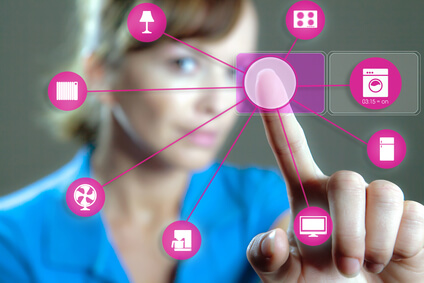In our latest blog post we’re providing an introduction to home automation. Many have heard this term before, but exactly does it mean? Let’s learn!
Home automation (also known as domotics or the “Internet of Things”) refers to the automatic and electronic control of household features, activity, and appliances. Various control systems are utilized in this residential extension of building automation.
Some components of an automated home may include the centralized control of security locks on doors and gates, appliances, windows, lighting, surveillance cameras and HVAC systems (heating, ventilation and air conditioning).
The Advantages of Home Automation
Home automation has increased in popularity over the past few years – especially with the rapid growth of mobile technology. One of the greatest advantages of an automated home is the ease with which functionality can be managed – not just via computers, but also with mobile devices such as tablets or smartphones. Before determining which home automation package is right for you, it is important to become understand the features and settings associated with home safety and security systems.
How Does Home Automation Work?
Home automation systems are comprised of hardware, communication and electronic interfaces that work to integrate electrical devices with one another. Domestic activities can then be regulated with the touch of a button. From any remote location, users can adjust the controls on home entertainment systems, limit the amount of sunlight given to houseplants, or change the temperatures in certain rooms. Home automation software is often connected through computer networks so that users can adjust settings on their personal devices.
The three main elements of a home security system are sensors, controllers and actuators. Sensors can monitor changes in daylight, temperature or motion detection; home automation systems can then adjust settings to the preferred levels of a user. Controllers refer to the devices—personal computers, tablets or smartphones—used to send and receive messages about the status of automated features in users’ homes. Actuators may be light switches, motors or motorized valves that control a mechanism or function of a home automation system.
What Features are Available Through Home Automation Systems?
The features and functions of home automation systems can vary widely. Some of the most common features available through these platforms may include fire and carbon monoxide monitoring, remote lighting control, thermostat control, appliance control, live video surveillance, security cameras, alarm systems and real-time text and email alerts. Homeowners can save on energy bills by reducing the length of time that lights stay on or lowering temperatures when they have left a room.
Why Do You Need Home Automation?
One of the greatest advantages of home automation systems is that users can protect against break-ins and fires, while enjoying automations for lights, temperature, and more. The automation of features in one’s home helps to promote security, comfort, energy efficiency, and convenience. Another benefit of home automation systems is the amount of labor, time, energy and materials that is saved. Home automation systems are more affordable than you might expect. As new technology continues to be introduced, prices for hardware are dropping. Likewise, operating systems are becoming less complex so that users can easily master all the controls associated with their safety and security devices.
Concluding Our Introduction To Home Automation
Whether you have a large family or are a household of one, home automation is great solution to your safety and security concerns. After the professional installation of a home automation system by Pegasus Low Voltage, you can begin to enjoy the benefits of leaving or returning to a safer and smarter home.
Our 5-Star online reviews showcase our dedication to excellent service! Call Pegasus Low Voltage today at 702-734-2787 to learn how you can increase the security and enhance the atmosphere of your home with a home automation system.

